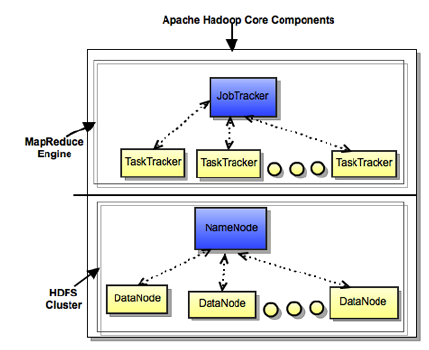Apache Hadoop is a framework that allows for the distributed processing of large data sets across clusters of commodity computers using a simple programming model. It is designed to scale up from single servers to thousands of machines, each providing computation and storage. Rather than rely on hardware to deliver high-availability, the framework itself is designed to detect and handle failures at the application layer, thus delivering a highly-available service on top of a cluster of computers, each of which may be prone to failures.
HDFS (storage) and MapReduce (processing) are the two core components of Apache Hadoop. The most important aspect of Hadoop is that both HDFS and MapReduce are designed with each other in mind and each are co-deployed such that there is a single cluster and thus provides the ability to move computation to the data not the other way around. Thus, the storage system is not physically separate from a processing system.
Hadoop Distributed File System (HDFS)
HDFS is a distributed file system that provides high-throughput access to data. It provides a limited interface for managing the file system to allow it to scale and provide high throughput. HDFS creates multiple replicas of each data block and distributes them on computers throughout a cluster to enable reliable and rapid access.
![[Note]](../common/images/admon/note.png) | Note |
|---|---|
A file consists of many blocks (large blocks of 64MB and above). |
The main components of HDFS are as described below:
NameNode is the master of the system. It maintains the name system (directories and files) and manages the blocks which are present on the DataNodes.
DataNodes are the slaves which are deployed on each machine and provide the actual storage. They are responsible for serving read and write requests for the clients.
Secondary NameNode is responsible for performing periodic checkpoints. In the event of NameNode failure, you can restart the NameNode using the checkpoint.
MapReduce
MapReduce is a framework for performing distributed data processing using the MapReduce programming paradigm. In the MapReduce paradigm, each job has a user-defined map phase (which is a parallel, share-nothing processing of input; followed by a user-defined reduce phase where the output of the map phase is aggregated). Typically, HDFS is the storage system for both input and output of the MapReduce jobs.
The main components of MapReduce are as described below:
JobTracker is the master of the system which manages the jobs and resources in the cluster (TaskTrackers). The JobTracker tries to schedule each map as close to the actual data being processed i.e. on the TaskTracker which is running on the same DataNode as the underlying block.
TaskTrackers are the slaves which are deployed on each machine. They are responsible for running the map and reduce tasks as instructed by the JobTracker.
JobHistoryServer is a daemon that serves historical information about completed applications. Typically, JobHistory server can be co-deployed with JobTracker, but we recommend to run it as a separate daemon.
The following illustration provides details of the core components for the Hadoop stack.


